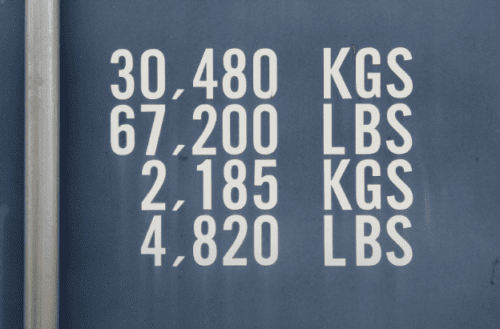Net Weight vs Gross Weight: Differences and Calculations

International shipments need the net, gross, and tare weights to ensure vessels are not overloaded. In addition, the quotes, paperwork, and bill of lading indicate which weights determine the shipment costs for the given freight company. Understanding the differences between the types of weights is critical to interpreting the paperwork.
Container weight is one of the primary components of the bill of lading. For example, light containers are usually placed on heavy containers during shipment to ensure a ship’s stability. Weight management mistakes or a weight that is not declared correctly can make a vessel sink, making weight declaration accuracy a critical component of safety and damage prevention or loss.
What Is Net Weight?
Net weight refers to the total weight of goods outside the transportation container and accessories such as dunnage. You can also define net weight as the total weight of your cargo minus the container’s tare weight. The net weight excludes only the weight of packaging and cargo protection equipment like shelves and pallets.
For example, if you export raw beans in cartons, only the beans count as net weight. But if you ship canned beans preserved in a liquid, the fluid counts towards the net weight.
How To Calculate Net Weight
Follow the steps below to get your net weight.
- Weigh the product while in its container or package to get the gross weight
- Remove the product from the package, then weigh the package to get the tare weight
- Subtract the tare from the gross weight to get the net weight
In short, the mathematical formula for net weight is;
Net weight = gross weight – tare weight, or
Net weight = product quantity * product weight
You can use the first formula when you don’t know the product quantity and weight. For instance, if you assume the gross weight of a shipment is 6200 kgs, and the tare weight is 1800 kg, you will need this formula.
Net weight = Gross weight – tare weight
Net weight = 6200 – 1800
Net weight = 4400 kgs
Here’s an example of when and how to use the second formula:
Suppose you want to export glass plates each weighing 0.2 KG without packaging. If you deliver 10 000 pieces, the net weight will be:
Net weight = product quantity * product weight
Net weight = 10 000 * 0.2
Net weight = 2 000 KGs
What Is Gross Weight?

Gross weight is the weight of your goods plus the package used for transportation. For instance, the gross weight of liquids is how much the liquid weighs plus the bottle or can in which it is stored. If the products are packed in cans and put in a carton, the weight of the cans and cartons contributes to the gross weight.
The gross weight includes the net and tare weight and the vessel. The gross weight for water transportation is the tare weight and your product’s net weight. However, the gross weight for road vehicles is the weight of the products being transported and the vehicle combined.
How To Calculate Gross Weight
To calculate the gross weight, add your product’s net weight to the container’s weight. Gross weight calculation can vary between different transportation modes. Here are some examples:
Air Transport
The gross weight calculation includes the plane’s weight, the people on board, and fuel.
Road Transport
Gross weight equals the truck’s weight plus the tare and net weight.
Water Transport
Add the net weight and tare weight to get the gross weight.
Mathematically, the formula to calculate gross weight is:
Gross weight = Tare weight + Net weight + Other Accessories
You can also calculate gross weight from the net weight. Once you have the net weight, add the weight of the empty container and other accessories to your products’ weight to get the gross weight. Consider the following example;
You want to export 2 000 duvets, each weighing 5 kg. The net weight will be 10 000 kg. Now you will need to send the duvets in a package. Consider that each package weighs 200 g. So the total packaging weight is 400 kg. railway 5.2 kg. Besides the items, you will need a container, so assume the container weighs 2800 kg.
In addition, you will need racks or pallets to hold your goods. If that is the case, the gross weight will include the weight of the racks/pallets. In the above example, assume you will need a 600 kg shelf. So, the total gross weight will be;
Gross weight = tare weight + net weight + Accessories (pallets and packaging)
Gross weight = 2 800 + 10 000 + (600+400)
Gross weight = 13 800 kg or 13.8 metric tonnes
Net Weight vs Gross Weight The Differences
The table below explores the differences between net weight and gross weight.
| Net Weight | Gross Weight |
|---|---|
| The weight of goods only | The total of goods plus the package, packaging, and accessories |
| Determines the weight of cargo before packaging | Determines the shipping costs |
| The calculation is constant in all modes of transport | The calculation depends on the transportation type |
| The calculation unit is kilograms or pounds | The calculation unit can be a metric ton or metric tons |
| Excludes the tare weight | Includes the tare weight |
Tare Weight and How It Relates
Also known as unladen weight, tare weight is the weight of an empty container or vehicle. The tare weight can either be actual or average tare weights. The actual tare is the actual weight of the container without the pallets and packaging. The average weight is the sum of the tare weight of several containers divided by the number of containers.
Tare weight is vital to the calculation of the gross or net weight. For example, if you add the tare weight to the net weight, you get the gross weight. You get the net weight if you deduct the tare weight from the gross weight. Mathematically,
- Gross weight = Tare weight + Net weight
- Net weight = Gross weight – Tare weight
- Tare weight = Gross weight – Net weight
You can find the tare weight printed on intermodal containers. The weights usually vary depending on the size of the container.
